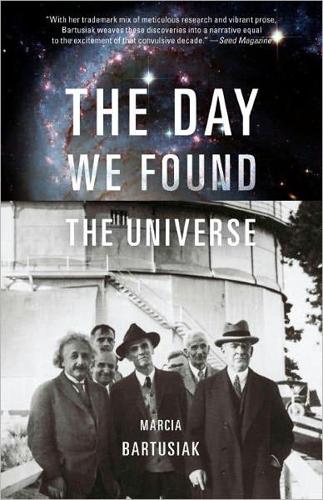
Day We Found the Universe
by
Marcia Bartusiak
Published 6 Apr 2009
Moreover, astronomers didn't yet know exactly how the Sun generated its tremendous power or that the solar orb was largely composed of hydrogen, even though Einstein's newly introduced theory relating mass to energy, nicely summarized as E = mc2, was offering a fresh clue. What 1920 is best remembered for in the annals of astronomy is Harlow Shapley and Heber Curtis meeting in Washington, D.C., before members of the National Academy of Sciences to argue the arrangement of the universe. The sides were now clearly drawn, and it was time for a showdown. Shapley had, of course, recently pronounced that the Milky Way was far bigger than previously assumed, easily imagining the spirals as minor players hovering on the edge of our vast system of stars.
…
Even though the telescope's mirror was relatively small, it allowed him to estimate that there were tens of thousands of faint nebulae arrayed over the celestial sky, ten times more than had been known before. In the 1910s Lick astronomer Heber Curtis followed up on Keeler's findings and gathered additional evidence to suggest that these many spiraling nebulae were nothing less than separate galaxies. At the same time, a few hundred miles south at Mount Wilson, near Los Angeles, Harlow Shapley resized the Milky Way, measuring it as far larger than previously thought and shoving our Sun off to the side, away from the galaxy's hub. As Shapley liked to put it, “The solar system is off center and consequently man is too.”
…
Exploration Empire Builder In 1914 the world was plunged into turmoil as the Allied and Central powers rapidly faced off in the War to End All Wars, the four-year conflict that demolished old empires and reshaped the modern world. And yet, in this time of devastating upheaval, astronomy experienced some of its greatest discoveries. Vesto Slipher was measuring the fleeing spirals, Heber Curtis was ferreting out new ones, and Harlow Shapley was gearing up to move our Sun from its hallowed position at the center of the known universe. While the landscape of global politics was being redesigned, so too was our cosmos. The Milky Way had long been pictured as relatively small, at most around 20,000 to 30,000 light-years wide (estimates at this time varied), but in 1918 Shapley radically increased our galaxy's girth to some 300,000 light-years.
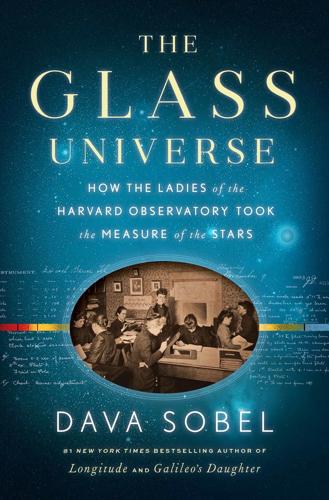
The Glass Universe: How the Ladies of the Harvard Observatory Took the Measure of the Stars
by
Dava Sobel
Published 6 Dec 2016
Solon Bailey completes a provisional catalogue of 76 globular clusters in the Annals, vol. 76. 1918 First of nine volumes of the greatly expanded Henry Draper Catalogue is published in the Annals, beginning with vol. 91. 1919 Edward Pickering dies. Solon Bailey serves as interim director. 1920 Harlow Shapley and Heber Curtis debate the scale of the universe. 1921 Harlow Shapley is named fifth director. Henrietta Leavitt dies Harlow Shapley and Annie Cannon explore the relation between spectral type and magnitude. 1922 International Astronomical Union adopts Harvard’s Draper stellar classification, representing the work of Williamina Fleming, Antonia Maury, and especially Annie Jump Cannon. 1923 Adelaide Ames enrolls as Harvard’s first graduate student in astronomy.
…
Cecilia Payne arrives from England as Harvard’s second graduate student in astronomy Harvard Reprints series initiated to disseminate staff members’ published articles in professional journals. 1924 Harlow Shapley issues the first in a series of papers detailing the distance, size, and structure of the Magellanic Clouds. Ninth volume of the Henry Draper Memorial is published in the Annals, vol. 99. 1925 Harlow Shapley introduces a new publication series of books, the Harvard Monographs, beginning with Cecilia Payne’s doctoral dissertation, Stellar Atmospheres. 1926 Harvard Bulletin switches to monthly publication, each issue containing several items of interest. Harlow Shapley introduces Harvard Announcement Cards for news (of comets, novae, asteroids) between issues of the Bulletin. 1927 Number of known variable stars reaches five thousand, more than four thousand of which are Harvard discoveries, found on the glass plates.
…
After completing her doctoral work at Harvard, she moved with her husband, Frank, to Canada, becoming the first woman to observe with large telescopes in British Columbia and Ontario. She popularized astronomy through her newspaper column and other writing. Arthur Searle (October 21, 1837–October 23, 1920) served at the observatory for fifty-two years, including a period as acting director after Joseph Winlock died. He assisted Pickering in photometry, and taught astronomy classes at Radcliffe. Harlow Shapley (November 2, 1885–October 20, 1972), the fifth director, from 1921 to 1952, added graduate education to the observatory’s mission. Using Cepheid variables and the period-luminosity relation, he showed the Sun to be far from the center of the Milky Way, contrary to previous belief.
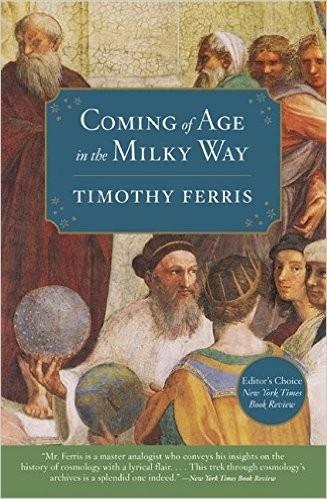
Coming of Age in the Milky Way
by
Timothy Ferris
Published 30 Jun 1988
Noteworthy Events: The 100-inch telescope at Mount Wilson, then the world’s largest, begins operation. Time: 1919 Noteworthy Events: English expedition to observe a solar eclipse confirms Einstein’s prediction that space, in a gravitational field, is strongly curved. Time: 1920 Noteworthy Events: The controversy over whether spiral nebulae are gaseous clouds or “island universes”—i.e., galaxies—comes to a head in a debate between Heber Curtis and Harlow Shapley. Time: 1922 Noteworthy Events: Ernst Öpik deduces, from rotation velocities and the mass to luminosity ratio of the Andromeda spiral, that it is a galaxy in its own right. Noteworthy Events: Aleksandr Friedmann shows that general relativity is consistent with an expanding-universe cosmology.
…
Time: 1916–1917 Noteworthy Events: Arthur Stanley Eddington demonstrates theoretically that stars are gaseous spheres; his work lays the foundation for his later assertion that gravitational contraction cannot be the mechanism that powers the stars. Time: 1917 Noteworthy Events: Heber Curtis and George Ritchey announce that they have found novae (stars that have suddenly increased tremendously in brightness) in the Andromeda spiral. Opinions differ on whether this means Andromeda is a galaxy of stars, or a gaseous nebula from which new stars are condensing. Noteworthy Events: Vesto Slipher measures large Doppler shifts in the spectra of spirals, later found to be due to the motion of the spiral galaxies in the expanding universe. Time: 1918 Noteworthy Events: Harlow Shapley determines, by studying the distances of globular clusters, that the sun lies toward one edge of a galaxy of stars.
…
Those who disagreed preferred to emphasize the word’s Latin etymology, from buccae, for “puffed up.” Among the dissidents was Heber Curtis of Lick Observatory, an advocate of the “island universe” theory. Shapley reacted to Curtis’s arguments with the abhorrence of a patient contemplating surgery: Curtis, he noted, “must shrink my galactic system enormously to have much luck with island universes.”11 The issue was formally debated by Shapley and Curtis under the auspices of the National Academy of Sciences, in Washington, D.C., on April 26, 1920. Shapley was generally judged the loser, but, as is usually the case in science, the debate settled little and the last word belonged not to men but to the sky.
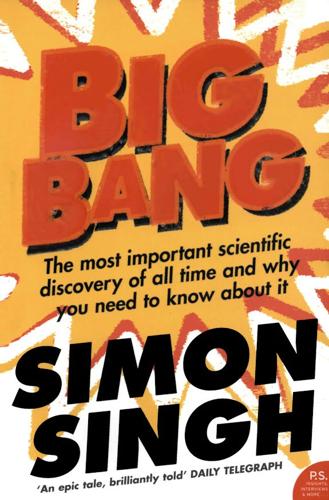
Big Bang
by
Simon Singh
Published 1 Jan 2004
By the year of the Great Debate, Shapley had established himself as part of the new generation of promising astronomers, but he still felt very much in the shadow of Curtis, and was grateful for the opportunity to escape his opponent’s intimidating personality when their Southern Pacific train broke down in Alabama. Shapley spent the time wandering along the tracks in search of ants, which he had studied and collected for many years. Figure 39 The two main protagonists in the Great Debate: young Harlow Shapley (left), who believed that the nebulae lay within the Milky Way galaxy; and the more senior Heber Curtis, who put forward the case that the nebulae were independent galaxies far beyond the Milky Way., When the night of the Great Debate finally arrived, Shapley’s nerves grew worse during the long-winded prize-giving ceremony that preceded the main event.
…
Were they part of our own Milky Way galaxy, or were they faraway galaxies in their own right? The matter came to a head in April 1920, when the National Academy of Sciences in Washington planned to host what would become known as the Great Debate. The Academy decided it should bring together the two opposing camps on the nature of nebulae to debate the question in front of the most eminent scientists of the age. The view that the Milky Way contains the entire universe, including the nebulae, was strongly championed by the astronomers at the Mount Wilson Observatory, and they sent an ambitious young astronomer, Harlow Shapley, to argue on their behalf. The opposing view, that the nebulae are galaxies in their own right, was popular at the Lick Observatory, who sent Heber Curtis to defend their position.
…
Our business in every generation is to reclaim a little more land. T.H. HUXLEY The less one knows about the universe, the easier it is to explain. LEON BRUNSCHVICG Errors using inadequate data are much less than those using no data at all. CHARLES BABBAGE Theories crumble, but good observations never fade. HARLOW SHAPLEY First, get the facts, then you can distort them at your leisure. MARK TWAIN Heaven wheels above you displaying to you her eternal glories and still your eyes are on the ground. DANTE Science consists of two complementary strands, theory and experiment. While theorists consider how the world works and build models of reality, it is the experimentalists who test these models by comparing them with reality.

The Milky Way: An Autobiography of Our Galaxy
by
Moiya McTier
Published 14 Aug 2022
Unfortunately, he reached his accurate conclusion only through faulty reasoning. He thought that the nebulae must be part of me, because in his head, I was far too large for there to be anything outside of my bounds. A more established astronomer named Heber Curtis disagreed with most of what Shapley said, especially the part about my being big enough to encompass the nebulae, which he believed were their own “island universes” just like me. In 1920, Shapley and Curtis were invited by the National Academy of Sciences in the US to publicly defend their respective views on the architecture of the universe. A whole room of people gathered to discuss my position!
…
By the twentieth century, the consensus among human astronomers was that my body was a flat disk about twenty thousand light-years across (the word “parsec” was just about to be invented in 1913 by an astronomer named Frank Dyson7) and that your sun sat somewhere near the middle. Will you humans ever miss an opportunity to try to put yourselves at the center of everything? A young rebel named Harlow Shapley had been using Cepheid variables (thanks to Henrietta Leavitt) to map globular clusters in my halo. Globular clusters are just what your astronomers call collections of gas, dust, and up to thousands of stars that are gravitationally bound together within a galaxy. Shapley drew two conclusions from his work.
…
That image held information about the size of M87’s central black hole (and therefore its mass) and the direction of its spin (the side moving towards you will appear brighter because of the Doppler effect). More observations revealed the strong, spiraling magnetic field lines around the black hole’s event horizon. This supported an early hypothesis from the 1970s about the formation of jets, which were first observed in 1918 by Heber Curtis of Great Debate fame. Roger Blandford and Roman Znajek were working at Cambridge University when they speculated—without a shred of evidence and probably over a spot of tea—that spinning black holes can twist their magnetic field lines into a spiral. Voltage traveling along the lines draws energy away from the accretion disk, and the black hole gets to put on a light show.
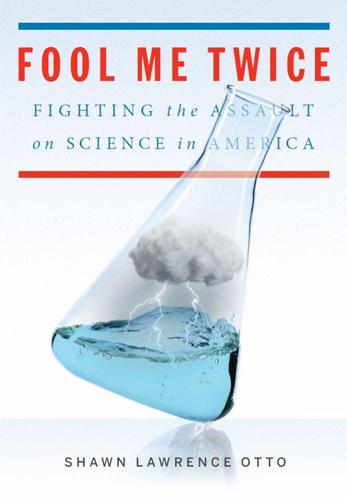
Fool Me Twice: Fighting the Assault on Science in America
by
Shawn Lawrence Otto
Published 10 Oct 2011
This overturned the concept of the centrality of humans yet again, and Shapley was celebrated as the greatest astronomer since Copernicus—a title he himself helped promote—for having achieved the “over-throw” of the heliocentric universe.26 THE GREAT DEBATE: A CAUTIONARY TALE In what would become an important cautionary tale for American science—and, by extension, democracy and much of what ails American politics today—Shapley became blinded to reality by his belief that the Milky Way was the entire universe—or maybe his hubris in wanting to believe that he had mapped the whole shebang. He argued that the spiral nebulae seen in the heavens were simply wisps of gas and clouds of dust within the Milky Way, rather than entire “island universes”—galaxies—of their own, as fellow astronomer Heber Curtis posited. He debated this point with Curtis at a meeting of the National Academy of Sciences in April of 1920, in an event famously called the Great Debate. The debate ended in a draw because there wasn’t yet enough observational data to draw firm conclusions, but this was partly because Shapley, without realizing it, had stopped using Locke’s and Bacon’s inductive reasoning to build knowledge from observation and was instead trying to prove his point with a rhetorical argument—an a priori, top-down, Cartesian approach of first principles that had him arguing more like an attorney than a scientist.
…
He found Cepheids close enough to Earth to measure the distance to them using statistical parallax and was able to compare this with their apparent brightness (their brightness as observed from Earth). The resulting formula allowed scientists to measure the distances to all Cepheid variables. These blinking stars became “standard candles” for measuring distance throughout the heavens. This was an immense discovery, and in 1915 American astronomer Harlow Shapley, a liberal Democrat, used it and Mount Wilson’s sixty-inch telescope to map the Milky Way in three dimensions. Shapley’s measurements expanded the known size of the Milky Way severalfold and showed that the sun was not at the center of the galaxy, as had been thought, but was in fact located in a distant outer arm.
…
In a way, the whole Apollo Program was a big show of American technological prowess and innovation—a show intended to influence public sentiment—that relied on science and just happened to spin off immense benefits. But the showmanship, wonder, and politics were lost on most other scientists, who saw no value—or worse, a negative value—in showing personality or telling engaging stories about their work intended to inspire the public. Hubris, after all, is what had ruined Harlow Shapley’s career; it was the gateway to the rosy path of a priori principles. From a pure science viewpoint, human spaceflight was wasteful. But from a public engagement and thus overall funding viewpoint, it was sheer genius, because it gave the public a narrative for appreciating science. It was in some senses an example of the third culture C.

From eternity to here: the quest for the ultimate theory of time
by
Sean M. Carroll
Published 15 Jan 2010
The most basic level is simply: The Second Law refers to closed systems, and an organism (or a species, or the biosphere) is not a closed system. We’ll discuss this a bit more in Chapter Nine, but that’s basically all there is to it. 32 Thompson (1862). 33 Pynchon (1984), 88. 3. THE BEGINNING AND END OF TIME 34 In fact there was a literal debate—the “Great Debate” between astronomers Harlow Shapley and Heber Curtis was held in 1920 at the Smithsonian in Washington, D.C. Shapley defended the position that the Milky Way was the entirety of the universe, while Curtis argued that the nebulae (or at least some of them, and in particular the Andromeda nebula M31) were galaxies like our own. Although Shapley ended up on the losing side of the big question, he did correctly understand that the Sun was not at the center of the Milky Way. 35 That’s a bit of poetic license.
…
So the relative smoothness of the early universe, illustrated in the image of the cosmic microwave background, reflects the very low entropy of those early times. THE UNIVERSE IS NOT STEADY The Big Bang model seems like a fairly natural picture, once you believe in an approximately uniform universe that is expanding in time. Just wind the clock backward, and you get a hot, dense beginning. Indeed, the basic framework was put together in the late 1920s by Georges Lemaître, a Catholic priest from Belgium who had studied at Cambridge and Harvard before eventually earning his doctorate from MIT.42 (Lemaître, who dubbed the beginning of the universe the “Primeval Atom,” refrained from drawing any theological conclusions from his cosmological model, despite the obvious temptation.)
…
There are many such interpretations on the market, and we’re going to discuss two: the more or less standard picture, known as the “Copenhagen interpretation,” and a view that seems (to me) to be a bit more respectable and likely to conform to reality, which goes under the forbidding name the “many-worlds interpretation.” Let’s look at Copenhagen first.199 The Copenhagen interpretation is so named because Niels Bohr, who in many ways was the godfather of quantum mechanics, helped to develop it from his institute in Copenhagen in the 1920s. The actual history of this perspective is complicated, and certainly involves a great deal of input from Werner Heisenberg, another quantum pioneer. But the history is less crucial to our present purposes than the status of the Copenhagen view as what is enshrined in textbooks as the standard picture.